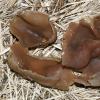
05-12-2025 17:33
 Bruno Coué
Bruno Coué
Bonjour, je serais heureux de recueillir votre avi

07-12-2025 09:24
De la pasada semana en Galicia EspañaEn el suelo

06-12-2025 00:19
 Viktorie Halasu
Viktorie Halasu
Hello, would anyone have this article, please? An

02-12-2025 18:59
This pair of ascos 2.5cm across were on recently b

02-12-2025 19:25
Buckwheat PeteHello, can anyone identify this hairy fungus growi

30-11-2025 12:53
 Edvin Johannesen
Edvin Johannesen
White short-stipitate apothecia found on thin twig
Peziza ?
John Plischke,
24-05-2008 06:25
 Peziza ? Growing on top of a bale of straw. Spores about 15 um long. Spore photo 400X. Mushrooms 1 to 2 inches wide.
Peziza ? Growing on top of a bale of straw. Spores about 15 um long. Spore photo 400X. Mushrooms 1 to 2 inches wide.
François Valade,
24-05-2008 09:28

Re:Peziza ?
John
There are too many missing information to help you more.
1/ it is probably a Peziza sp. although you did not mention if the iodine blue reaction at ascus tip was checked.
2/ spores are smooth or not, guttulate or not (I guess it is), width
Spores have to be examined outside asci in cotton blue
3/ paraphysis, shape, tip, gel cap, width
4/ flesh : thickness, textura, layers
In Europe, with such substrate, Peziza vesiculosa is frequent. it is a big ochraceous yellow species (up 10 cm, 4 inches?), vesicle shape, but with longer smooth spores. I know several european Peziza keys, maybe not totally suitable for America, but have not in mind such work for american species.
Let us wait for Dick Korf's point of view.
François
There are too many missing information to help you more.
1/ it is probably a Peziza sp. although you did not mention if the iodine blue reaction at ascus tip was checked.
2/ spores are smooth or not, guttulate or not (I guess it is), width
Spores have to be examined outside asci in cotton blue
3/ paraphysis, shape, tip, gel cap, width
4/ flesh : thickness, textura, layers
In Europe, with such substrate, Peziza vesiculosa is frequent. it is a big ochraceous yellow species (up 10 cm, 4 inches?), vesicle shape, but with longer smooth spores. I know several european Peziza keys, maybe not totally suitable for America, but have not in mind such work for american species.
Let us wait for Dick Korf's point of view.
François
René Dougoud,
25-05-2008 21:10
Re:Peziza ?
Chers Tous,
Il est possible qu'il s'agisse de P. vesiculosa, elle en tout à fait le faciès Ce qu'il est intéressant, de savoir s'agissant de cette espère et qu'il arrive que les asques ne réagissent pas à l'iode. J'ai eu le cas sur deux récoltes dont l'une faite sur de la paille. Cette particularité, qui peut être déconcertante, est signalée par GRELET, dans "Les Discomycètes de France" rééd.1978 p. 62.
Salutations
René
Il est possible qu'il s'agisse de P. vesiculosa, elle en tout à fait le faciès Ce qu'il est intéressant, de savoir s'agissant de cette espère et qu'il arrive que les asques ne réagissent pas à l'iode. J'ai eu le cas sur deux récoltes dont l'une faite sur de la paille. Cette particularité, qui peut être déconcertante, est signalée par GRELET, dans "Les Discomycètes de France" rééd.1978 p. 62.
Salutations
René

